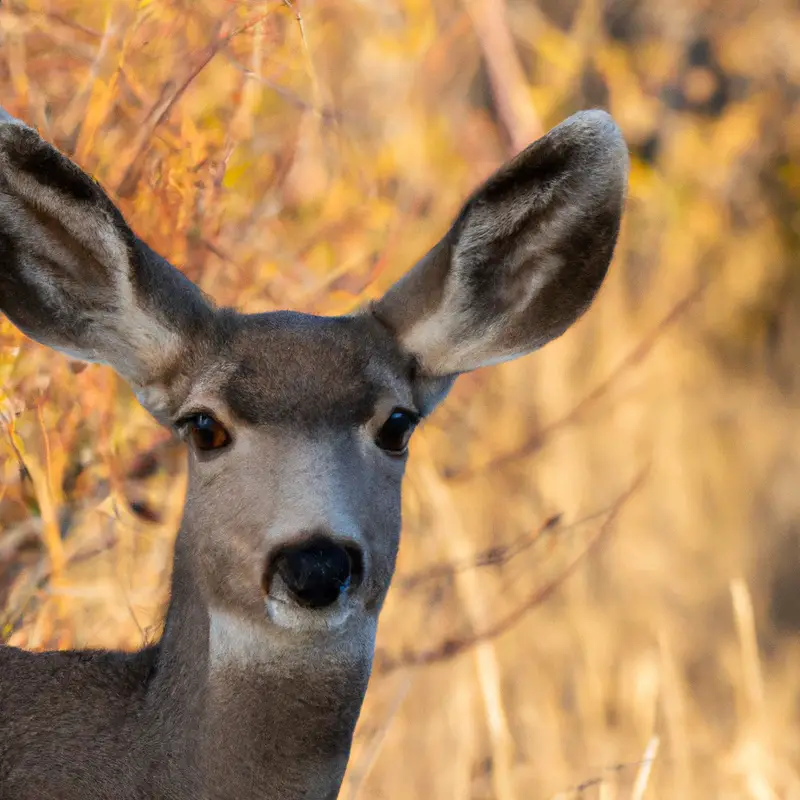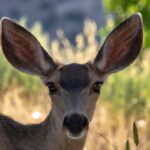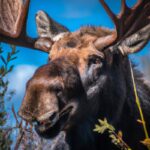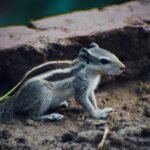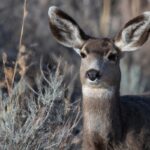Key Takeaways:
- Mule deer hunting in Colorado requires a specific license and adherence to strict hunting regulations.
- Proper scouting techniques and knowledge of deer behavior are essential for successful mule deer hunting in Colorado.
- Hunters should focus on high-elevation areas with varied landscapes and ample vegetation to increase their chances of spotting mule deer.
- Mule deer hunting during the rutting season can provide higher success rates as deer are more active and visible during this time.
Are you ready for an epic hunting adventure?
Picture this: you, amidst the breathtaking landscapes of Colorado, stalking one of the most elusive and majestic creatures, the mule deer.
But hunting mule deer in Colorado is not just about the thrill of the chase; it’s about understanding their behavior, navigating their habitat, and employing the right strategies for a successful hunt.
As an experienced hunter and Colorado native, I’ll share with you everything you need to know about mule deer hunting in Colorado.
From obtaining licenses to scouting techniques, I’ve got you covered.
So, grab your gear and let’s embark on an unforgettable journey into the wild.
| Hunting Mule Deer in Colorado | |
|---|---|
| Location | Colorado |
| Season | October-November |
| License/Permit Cost | $45 (resident) / $397 (non-resident) |
| Bag Limit | 1 buck per season |
| Method of Take | Rifle, muzzleloader, or archery |
| Accommodation | Camping, cabin rentals, or hotels |
| Difficulty Level | Medium |
Overview of Mule Deer Hunting in Colorado
Why Colorado is a popular destination for mule deer hunting
Colorado is a top choice for mule deer hunting due to its abundant population of mule deer. The state offers vast and diverse habitats, ranging from mountains to plains, which provide perfect conditions for mule deer to thrive.
Colorado’s sizeable public lands and access to private lands through partnerships allow hunters ample opportunities to pursue mule deer.
Additionally, the state’s management practices prioritize sustainable hunting, ensuring a healthy and stable population of mule deer for future generations. The breathtaking scenery and adventurous experience of hunting in Colorado make it a preferred destination for mule deer enthusiasts.

Overview of mule deer hunting seasons in Colorado
Colorado offers various hunting seasons for mule deer, providing hunters with ample opportunities to pursue this majestic species. These seasons typically run from late summer through early winter, ensuring different hunting experiences based on the time of year.
The archery season is usually the first to open, followed by the muzzleloader and rifle seasons.
Exact dates and regulations can vary each year, so it’s essential to check the Colorado Parks and Wildlife website for the most up-to-date information. Keep in mind that proper licensing and adherence to hunting regulations are crucial for a successful and ethical hunting experience.
Understanding mule deer behavior and habitats in Colorado
Understanding mule deer behavior and habitats in Colorado is essential for a successful hunting experience.
Mule deer are commonly found in areas with open grasslands and forests, particularly in the foothills and mountainous regions.
They are known for their ability to adapt to different environments and can be found at various elevations.
Mule deer are most active during dawn and dusk, so it’s important to plan your hunting trips accordingly.
Additionally, mule deer are known to be cautious and have excellent senses, including their sense of smell and hearing.
Taking these factors into account will greatly increase your chances of spotting and successfully hunting mule deer in Colorado.
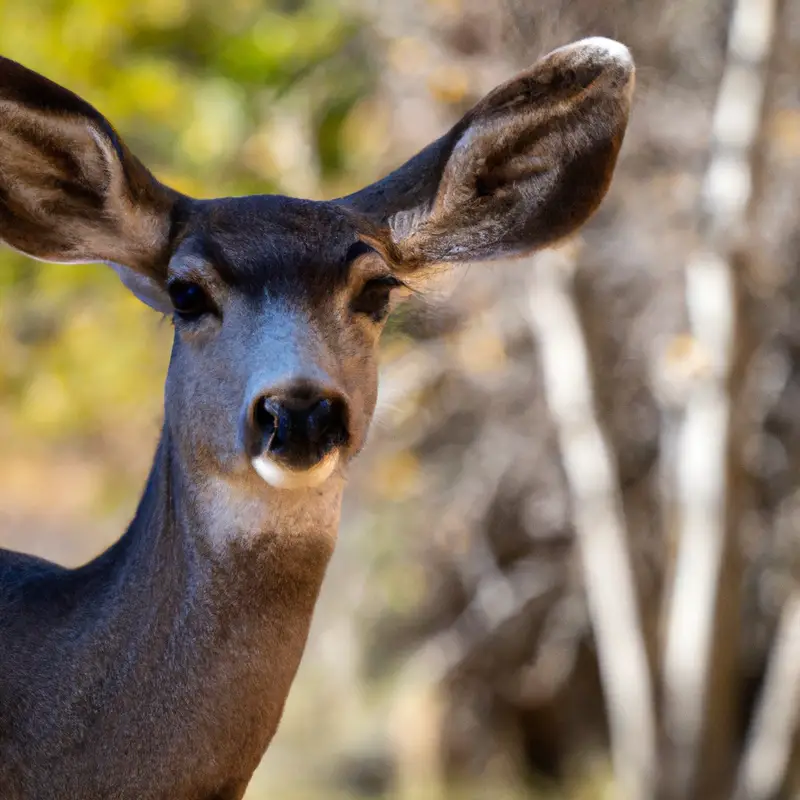
Preparing for a Mule Deer Hunt in Colorado
Gear and equipment needed for mule deer hunting in Colorado
When heading out for mule deer hunting in Colorado, there are a few gear and equipment essentials you’ll need for a successful hunt. Here’s a quick rundown:
- Weapon: Bring a rifle or bow that you’re comfortable and proficient with for taking down mule deer.
- Optics: Invest in quality binoculars and a spotting scope to help you spot deer from a distance and assess their size and antler quality.
- Clothing and footwear: Dress in layers to adapt to changing weather conditions. Opt for camouflage clothing that blends with the environment, and wear sturdy, comfortable boots for long hikes.
- Backpack: Carry a backpack to hold essentials like water, snacks, and field dressing equipment. Look for a pack that is lightweight and has enough capacity for your needs.
- Hunting knife and game bags: A sharp, durable knife is essential for field dressing and processing your harvested deer. Game bags come in handy for storing and transporting the meat.
- Calls and scents: Bring deer calls and attractant scents to lure mule deer within shooting range.
- Field processing kit: Include essentials like latex gloves, plastic bags, and rope for field dressing and transporting your harvested deer.
Remember to check the specific hunting regulations and requirements in Colorado, as well as any additional gear recommendations from experienced hunters in the area. Happy hunting!
Physical fitness and conditioning for hunting in Colorado’s terrain
Physical fitness plays a key role in hunting in Colorado’s rugged terrain. To prepare, focus on improving your cardiovascular endurance, as you’ll be hiking and climbing at high altitudes.
Incorporating strength training exercises, such as lunges and squats, will help build your leg muscles for traversing uneven terrain.
Don’t forget to train your upper body by incorporating exercises like push-ups and rows, as they will come in handy when carrying gear or dragging game. Lastly, don’t underestimate the importance of flexibility and balance in navigating tricky terrain.
Stretching and practicing yoga can be beneficial.
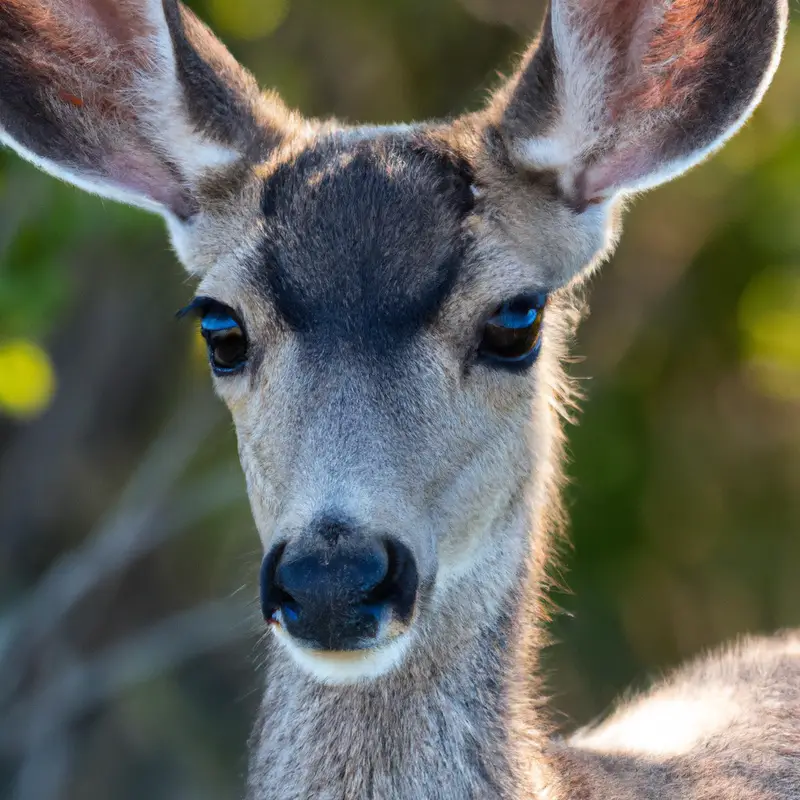
Understanding and practicing ethical hunting practices
Understanding and practicing ethical hunting practices is essential for responsible hunters. Here are some key principles to keep in mind:
- Respect for wildlife: Treat all animals with respect and appreciation for their natural environment. Only take shots at an animal that you are certain you can cleanly kill and recover.
- Comply with regulations: Know and follow the hunting and firearm laws in your area. Observe hunting seasons, bag limits, and other restrictions. Always obtain the necessary licenses and permits.
- Respect private property: Obtain permission from landowners before hunting on their property. Leave gates as you find them and clean up after yourself. Practice good land stewardship.
- Practice responsible firearm usage: Maintain and safely handle your firearms. Regularly practice marksmanship skills to ensure a clean and ethical shot. Always be aware of your surroundings and potential for accidental harm.
- Practice fair chase: Avoid using unfair tactics that give you an unfair advantage over the animals. This includes baiting, spotlighting, and excessive use of technology.
- Utilize the animal: Utilize the entire animal you harvest to minimize waste. Donate excess meat to those in need, and properly dispose of all remains.
Strategies for Successful Mule Deer Hunting in Colorado
Scouting techniques and finding mule deer hotspots in Colorado
To scout for mule deer and find the best spots in Colorado, start by researching areas with high deer populations.
Look for public lands, national forests, and wildlife management areas.
Once you’ve identified potential locations, focus on finding areas with adequate food, water, and cover.
Look for fresh tracks, scat, and rubs as indicators of recent deer activity.
Additionally, consider the terrain and topography, as deer often prefer specific habitats.
Remember to scout during early mornings and evenings to increase your chances of spotting deer.
Deciphering mule deer signs and tracks in Colorado
To decipher mule deer signs and tracks in Colorado, there are a few key things you should look for. Firstly, pay close attention to tracks in the dirt or mud, as they can give you a sense of the deer’s size and where they’re heading.
Secondly, look for fresh droppings, as this indicates recent deer activity in the area.
Additionally, keep an eye out for rubbed trees and shrubs, as these are signs that bucks have been marking their territory. Lastly, look for deer beds, which are depressions in the ground where deer have rested.
By observing these signs, you can increase your chances of locating and hunting mule deer successfully in Colorado.
Choosing the right firearm or bow for mule deer hunting in Colorado
When choosing a firearm or bow for mule deer hunting in Colorado, there are a few key factors to consider.
Firstly, determine your preferred shooting distance.
For longer ranges, a rifle with a flatter trajectory is ideal, while for closer ranges, a bow can provide a more challenging and rewarding experience.
Additionally, consider the terrain you will be hunting in.
A lightweight bow may be better for maneuvering through dense forests, while a heavier rifle can provide stability on open plains.
Finally, make sure to practice with your chosen weapon to ensure accuracy and familiarity in the field.
Field Dressing and Processing Mule Deer in Colorado
Proper field dressing techniques for mule deer in Colorado
Proper field dressing techniques for mule deer in Colorado are important to ensure the meat stays fresh and safe for consumption.
Here are a few tips:
- Start by field dressing the deer as soon as possible after the kill. This involves making a small incision in the abdomen and carefully removing the internal organs.
- Keep the meat clean and dry throughout the process. Avoid touching the meat with dirty hands or laying it on the ground.
- Cool the meat quickly by hanging it in a shaded area with good air circulation. If the weather is warm, consider using ice packs or a portable cooler.
- Remove the hide, making sure to avoid any hair or debris from getting on the meat.
- Butcher the deer into manageable cuts, taking care to remove any bruised or damaged meat.
Remember, the key is to field dress the deer promptly, keep the meat clean and cool, and butcher it properly.
Happy hunting!
Tips for efficiently processing mule deer meat in Colorado
Efficiently processing mule deer meat in Colorado can be a rewarding experience. Here are some tips to help you make the most of it:
- Start by field dressing the deer as soon as possible after the kill. This involves removing the internal organs to prevent spoilage.
- Keep the meat clean and cool during transportation. Use game bags or a cooler with ice to maintain its freshness.
- Once you’re ready to process the meat, use a sharp knife to carefully remove the hide. Take your time to avoid any unnecessary waste.
- Separate the different cuts of meat, such as the tenderloins, backstraps, and roasts. This will make it easier to prepare and cook later on.
- Trim any excess fat and connective tissue from the meat. This will enhance the overall flavor and tenderness.
- Decide on the desired cuts and packaging method. Vacuum-sealing or wrapping in freezer paper can help preserve the meat’s quality for longer.
- Properly label and date the packaged meat before storing it in the freezer. This will ensure easy identification and prevent any confusion later on.
Remember, handling and processing mule deer meat with care will ensure that you get the most out of your hunting experience in Colorado. Happy processing and happy cooking!
Preserving and preparing mule deer meat for consumption
Preserving and preparing mule deer meat for consumption is an important part of your hunting experience.
After field dressing your deer, it’s crucial to cool it down quickly to prevent spoilage.
Remove the skin, fat, and connective tissue before cutting the meat into smaller portions.
Wrap the meat tightly in butcher paper or vacuum-seal it to preserve its freshness.
When it comes to cooking, consider marinating the meat to enhance its flavor and tenderness.
Whether you choose to grill, roast, or stew the meat, make sure it reaches the appropriate internal temperature for safe consumption.
Properly handled and cooked mule deer meat can be a delicious and nutritious reward for a successful hunt.
Utilizing the entire animal: processing antlers and hides
When processing a mule deer, it’s important to utilize the entire animal, including the antlers and hides.
One way to make use of the antlers is by turning them into unique decorative pieces or using them for crafts.
As for the hide, it can be tanned and turned into beautiful leather products like gloves, bags, or even rugs.
By maximizing the use of these parts of the animal, you can honor the hunt and create lasting reminders of your experience.
Safety Tips and Regulations for Mule Deer Hunting in Colorado
Firearm safety guidelines and regulations in Colorado
When hunting with firearms in Colorado, it is important to adhere to the state’s safety guidelines and regulations. Some key points to remember include:
- Always treat every firearm as if it is loaded, even if you believe it is not. Keep the muzzle pointed in a safe direction and your finger off the trigger until ready to shoot.
- Obtain the appropriate hunting license and tags, and be aware of the specific dates and areas open for hunting mule deer.
- Familiarize yourself with Colorado’s hunting regulations, including bag limits, allowable hunting methods, and the use of specialized equipment such as suppressors and crossbows.
- Make sure to wear bright orange or fluorescent pink clothing as required by law, as it increases your visibility to other hunters and helps prevent accidents.
- Understand the basics of firearm operation and safety, including proper loading and unloading procedures, as well as safe shooting practices.
- Before heading out, inform someone of your hunting plans, including your intended location and estimated return time. This simple precaution can help ensure your safety in case of an emergency.
Safety precautions for hunting in Colorado’s backcountry
When hunting in Colorado’s backcountry, safety should be your top priority.
Here are some important precautions to keep in mind:
- Knowledge of the area: Familiarize yourself with the terrain, weather conditions, and potential hazards of the backcountry you’ll be hunting in. This will help you plan and prepare accordingly.
- Communicate your plans: Inform a trusted person about your hunting plans, including your expected return time. This way, someone will know to alert authorities if you’re overdue.
- Carry essential gear: Pack a first aid kit, map, compass, GPS device, headlamp, extra food, water, and proper clothing for unpredictable weather. Make sure you have the necessary hunting licenses and tags as well.
- Stay alert and aware: Keep an eye out for other hunters, wildlife, and changing conditions. Be cautious of steep slopes, loose rocks, and potentially dangerous wildlife encounters.
- Fire safety: Follow fire regulations and guidelines to prevent wildfires. Be responsible when it comes to campfires and ensure they are fully extinguished before leaving.
- Respect private property and public lands: Always seek permission before hunting on private property. When on public lands, follow all regulations and practice Leave No Trace principles.
Remember, these precautions are meant to ensure both your safety and the preservation of the backcountry.
Happy hunting!
Tips for hunting in Colorado’s changing weather conditions
Hunting in Colorado can be challenging due to the changing weather conditions.
Here are a few tips to help you navigate the ever-changing climate:
- Layer up: Dress in layers to easily adjust to temperature fluctuations throughout the day. This will help you stay comfortable and avoid overheating or getting too cold.
- Check the forecast: Keep an eye on the weather forecast before heading out. This will give you an idea of what to expect and allow you to plan accordingly.
- Be prepared for rain and snow: Pack waterproof and insulated gear to stay dry and warm in case of unexpected rain or snowfall. This will ensure that you can continue hunting without discomfort.
- Stay hydrated: Even in cooler weather, it’s important to stay hydrated. Bring enough water with you to keep yourself adequately hydrated throughout your hunting trip.
- Be flexible with your hunting plans: Take into account the weather conditions and adjust your hunting strategy accordingly. For example, if it’s raining heavily, consider hunting in areas with good cover or focus on stalking instead of sitting in a blind.
Remember, Colorado’s weather can change rapidly, so always be prepared for unexpected weather conditions.
Stay safe and enjoy your hunting experience!
Frequently Asked Questions (FAQs) about Mule Deer Hunting in Colorado
What is the best time of year to hunt mule deer in Colorado?
The best time of year to hunt mule deer in Colorado is during the fall season.
Mule deer breeding season, also known as the rut, typically occurs in late October and early November.
During this time, the bucks are more active and easily located, making it easier for hunters to track and hunt them.
Additionally, the cooler temperatures in the fall make it more comfortable for hunters to spend long hours in the field.
How do I apply for a mule deer hunting license in Colorado?
To apply for a mule deer hunting license in Colorado, you can do it online through the Colorado Parks and Wildlife website.
The application process involves providing your personal information, selecting the type of license you want, and paying the required fees.
Make sure to check the specific hunting regulations and seasons before applying.
Once your application is submitted and processed, you will receive your hunting license if approved.
It’s important to stay updated with any changes or additional requirements from the Colorado Parks and Wildlife department.
What are the bag limits and regulations for hunting mule deer in Colorado?
In Colorado, the bag limit and regulations for hunting mule deer vary depending on the specific hunting season and the type of license you hold. Generally, hunters are allowed to harvest one buck per year, and there are restrictions on the size and age of the buck.
Additionally, there may be specific dates for hunting mule deer, and it is important to check the current regulations set by the Colorado Parks and Wildlife to ensure compliance.
It is also crucial to have the appropriate hunting license and tags before embarking on your mule deer hunting adventure in Colorado.
Are there any specific restrictions on mule deer hunting methods in Colorado?
In Colorado, there are specific restrictions on mule deer hunting methods to ensure sustainable wildlife management.
Here are some of the main restrictions you should be aware of:
- Hunting Season: Mule deer hunting is only allowed during specific seasons, which are determined by the Colorado Parks and Wildlife Department. It’s important to check the dates and regulations for the particular hunting unit you plan to visit.
- Licensing and Tags: To hunt mule deer in Colorado, you must possess a valid hunting license and a deer tag specific to the unit you will be hunting in. These licenses and tags can be obtained through the Colorado Parks and Wildlife Department.
- Weapon Restrictions: Different hunting units may have specific weapon restrictions, such as archery-only seasons or limited firearm use. Make sure you understand the regulations regarding the use of firearms, bows, and other hunting implements for mule deer hunting in your chosen unit.
- Daily and Season Bag Limits: Colorado has specific bag limits for mule deer hunting, which outline the number of deer you can legally harvest per day and per hunting season. These limits are in place to protect the mule deer population and enforce sustainable hunting practices.
- Hunting Methods: While Colorado allows various hunting methods for mule deer, including spot-and-stalk, stand hunting, and calling, there are restrictions on using bait and electronic devices. It’s essential to familiarize yourself with the specific regulations for the hunting unit you will be in.
Remember, hunting regulations can change, so always check with the Colorado Parks and Wildlife Department for the most up-to-date information.
By adhering to these restrictions, you can ensure a safe and responsible mule deer hunting experience in Colorado.
Final Verdict
Hunting mule deer in Colorado offers a thrilling and rewarding experience for both seasoned hunters and beginners alike. Colorado’s diverse landscapes and abundant mule deer population make it a prime destination for hunters.
By obtaining the necessary licenses, preparing the right gear, understanding mule deer behavior, and practicing ethical hunting practices, one can greatly increase their chances of a successful hunt.
Remember to prioritize safety and adhere to all regulations. So, grab your gear and embark on a memorable mule deer hunting journey in the beautiful state of Colorado.
Happy hunting!
